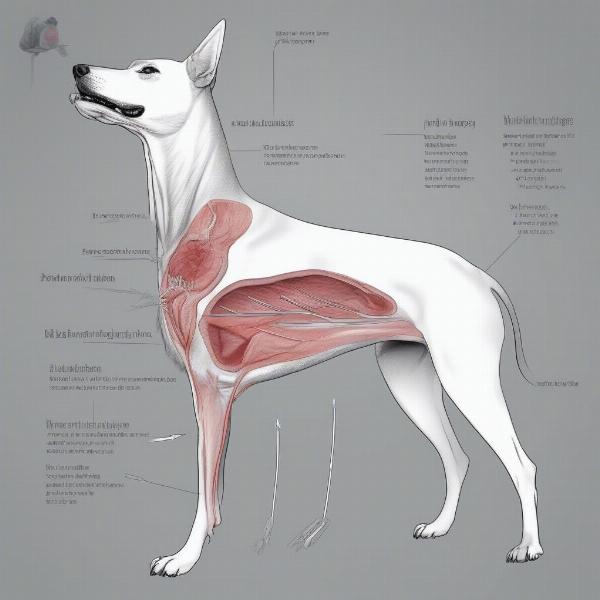Sheath tumors in dogs, also known as transmissible venereal tumors (TVTs), are unusual cancerous growths that can occur in the genital area of both male and female dogs. While the name might sound alarming, these tumors are often benign and treatable. This article provides a comprehensive guide to understanding sheath tumors in dogs, covering causes, symptoms, diagnosis, treatment, and prevention.
Understanding Canine Sheath Tumors
Sheath tumors are unique in that they are transmitted through direct contact, typically during mating. They affect the external genitalia of dogs, appearing as cauliflower-like growths. While they are technically cancerous, they rarely spread to other parts of the body and are often successfully treated.
While any dog can develop a sheath tumor, they are more common in intact males and females, especially those who roam freely or live in areas with high dog populations. Understanding the nature of these tumors is crucial for responsible pet ownership.
Identifying Symptoms of Sheath Tumors
The most noticeable symptom of a sheath tumor is a visible growth on the dog’s genitalia. In males, these growths can appear on the penis or prepuce (foreskin). In females, they are typically found on the vulva. The tumors can vary in size and appearance, but they often have a fleshy, pink or red color and a bumpy surface.  Dog with sheath tumor showing location
Dog with sheath tumor showing location
Other signs might include bleeding or discharge from the affected area, licking or scratching at the genitals, and difficulty urinating or mating. If you notice any of these symptoms, it’s important to consult a veterinarian for a proper diagnosis.
Diagnosis and Treatment Options
Diagnosing a sheath tumor typically involves a physical examination by a veterinarian. They may also take a small sample of the tumor tissue (biopsy) for microscopic examination to confirm the diagnosis and rule out other conditions.
Several treatment options are available for sheath tumors, with chemotherapy being the most common and effective approach. Surgery is generally not recommended due to the tumor’s location and vascularity. In some cases, the tumors may regress spontaneously, but veterinary intervention is usually necessary for complete resolution.
Preventing Sheath Tumors in Dogs
The most effective way to prevent sheath tumors is to spay or neuter your dog. This eliminates the risk of transmission during mating and significantly reduces the likelihood of developing these tumors. Limiting your dog’s exposure to other dogs, especially those with unknown health histories, can also help reduce the risk of transmission.
Conclusion
Sheath tumors in dogs can be concerning, but with early detection and proper treatment, the prognosis is generally good. Regular veterinary check-ups and responsible pet ownership practices, such as spaying/neutering, can significantly reduce the risk of your dog developing this condition. By staying informed and proactive, you can help ensure your furry friend’s long-term health and well-being.
FAQ
- Are sheath tumors contagious to humans? No, sheath tumors are not transmissible to humans.
- Can sheath tumors spread to other parts of the dog’s body? While rare, it’s possible for sheath tumors to metastasize, especially in cases with weakened immune systems.
- How long does chemotherapy treatment for sheath tumors typically take? The duration of chemotherapy varies depending on the individual case, but it typically involves several weeks of treatment.
- What is the recovery rate for dogs with sheath tumors? With appropriate treatment, the recovery rate for sheath tumors is generally high.
- Are there any alternative treatments for sheath tumors? While chemotherapy is the standard treatment, some holistic approaches may be considered in conjunction with conventional veterinary care. Always consult your veterinarian before trying alternative treatments.
- Can a dog with a sheath tumor still be bred? Breeding a dog with a sheath tumor is not recommended due to the risk of transmission.
- What should I do if I suspect my dog has a sheath tumor? Contact your veterinarian immediately for an examination and diagnosis.
About ILM Dog
ILM Dog is your trusted source for expert advice on all aspects of dog care and wellbeing. We offer comprehensive resources on dog breeds, health, training, nutrition, grooming, and much more. From choosing the right breed to navigating health concerns, our expert team is dedicated to providing valuable insights to help you give your furry companion the best possible care. For expert advice tailored to your dog’s specific needs, contact us at [email protected] or call us at +44 20-3965-8624. Visit ILM Dog today!